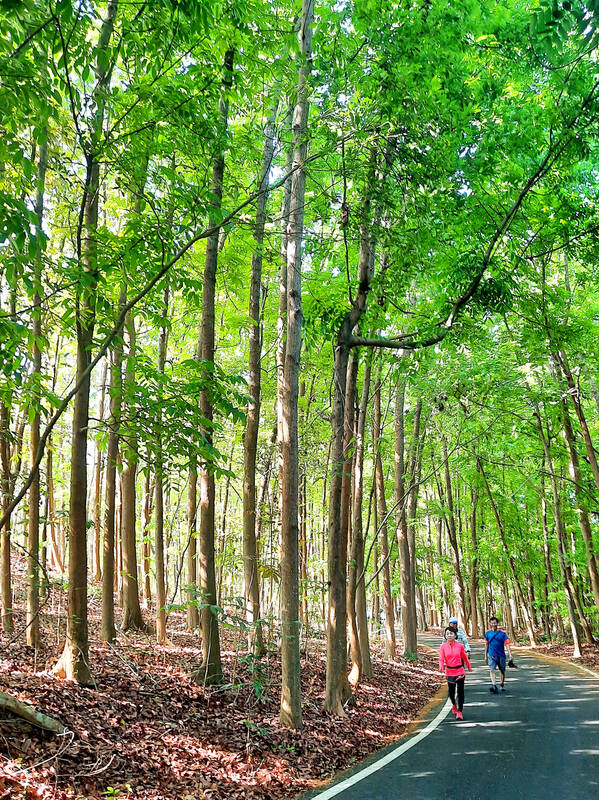A great deal of travel writing falls into one of two categories. There’s “first encounter” writing, in which the author recalls their first visit to a place, or the first time they came across a particular cultural practice. And then there’s the “guidebook” approach, in which the description of a location is the result of multiple visits to it over months or even years.
Or, to put it another way, tales of discovery versus tales of familiarity.
This article is an example of the latter. For the better part of a decade, I’ve been coming to a corner of Tainan where Guanmiao District (關廟) borders Longci District (龍崎), to ramble on foot or by bicycle.

Photo: Steven Crook
It’s a pleasing blend of tiny farms, minor hills and bamboo groves. I can’t say the area offers unspoiled countryside, as Freeway 3 slices through this landscape, much of which is 50 to 100m above sea level. Yet, even when fast traffic is audible, the woodlands hereabouts provide a very worthwhile escape-from-the-city experience.
I’m certainly not the only person who thinks that. Every time I go through what bilingual signs refer to as the Mahogany Forest Park (桃花心木森林公園) — also known as Guanmiao Forest Trail (關廟森林步道) — I meet other people taking photos or doing exercise. The area is kept tidy by volunteers who sweep leaves off the road surface.
If you’ve not been to the Mahogany Forest before, finding it can be a little tricky. First, get onto Wanglai Road (旺萊路) near central Guanmiao, then look for Dongrong Street (東榮街). The latter goes past ordinary homes and then several small factories before climbing steeply.

Photo: Steven Crook
There are clusters of graves on both sides of the road, and a few vegetable patches. If you’re riding a bike or a motorcycle, you can stop almost anywhere. If you’re in a car, however, the best place to park without inconveniencing others is at the Temple of the Three Marshals (三元帥廟), just under 2km from the Wanglai Road-Dongrong Street intersection. There’s space for four or five vehicles, but no bathroom.
By the time you get to the temple, it’ll be obvious that the surrounding forest is a plantation rather than one of Mother Nature’s efforts. Yet it’s a lovely sight whatever the month, whether it’s just after dawn, the middle of the day or close to dusk.
The finest views are to be had by following the car-width road from the Temple of the Three Marshals to a point about 800m to the south. Beyond that, the road descends past stands of bamboo, then runs parallel to Freeway 3 for a short distance.

Photo: Steven Crook
The Guanmiao-Longci mahogany plantation dates from the late 1990s, when 100 hectares of slopeland was afforested by its owner, Taiwan Kagome Co Ltd (臺灣可果美), to underscore its commitment to the environment. Some 60 hectares were planted with Honduras mahogany (Swietenia macrophylla), while the remainder is covered by a mix of hoop pine (Araucaria cunninghamii), smooth narra (also known as Philippine mahogany, Pterocarpus indicus), and an endemic evergreen, Machilus zuihoensis.
As its name suggests, Honduras mahogany is native to Central America. It’s now fairly common in central and southern Taiwan, where it’s grown to provide shade, timber for furniture and musical instruments and extracts that are used in traditional Chinese medicine.
Something about this terrain — probably the numerous gulches and gullies that break up the surface, and make venturing more than a meter or two from the asphalt inadvisable — facilitates mosquito breeding. For many visitors, the near certainty they’ll get bitten is their only complaint. But it’s a common gripe, whatever the season.

Photo: Steven Crook
The road through the Mahogany Forest continues under the freeway, then goes uphill to a small village called Dasi (大溪), where the main landmark is Jhongkeng Cingshuei Temple (中坑里清水宮). From Dasi, one can ride or drive to Road 182, or take a delightful road southward toward Alian (阿蓮) in Kaohsiung.
A few times, I’ve left my bike or motorcycle under the freeway, and walked up a steep concrete track that’s just to the east of the fast road, on the southside of a creek.
It leads past tracts of man-made forest and pineapple fields to a bridge over Freeway 3. On the other (seaward) side, there’s a very narrow “road” that’s been damaged by the elements and distorted by soil erosion to the point where ordinary two-wheelers shouldn’t attempt it. Mountain bike enthusiasts have marked out an MTB route along it, but I’ve not been able to discover where it starts and ends, its precise length or if there are regular events.
After around 900m of meandering through the Taiwan Kagome estate, this strip of broken-up concrete reaches a dank yet mercifully short tunnel under the freeway. On the other side, it joins up with a much more user-friendly road just behind Guanmiao Service Area (關廟服務區) on Freeway 3 — and within 300m, as the crow flies, of the final resting place of Taiwan’s ketchup king.
According to one biography, Lin Hsi-chih (林錫池, 1918-1995) was a ninth-generation descendant of settlers from Fujian. Educated during the 1895-1945 period of Japanese rule, the postwar years found him teaching at what’s now National Cheng Kung University. Later, he launched a company to export bananas and canned food to Japan.
In 1967, he entered into a joint venture with Japan’s Kagome Co Ltd. Production of tomato-based products began the following year, and Taiwan Kagome soon became synonymous with tomato ketchup and tomato juice. The company, now managed by Lin’s grandson, has since expanded into vegetable and fruit juices.
In addition to his contributions to Taiwan’s processed foods industry, Lin might well have had a hand in creating the corporate culture that resulted in one of Tainan’s most attractive and accessible woodlands. I’m willing to give him the benefit of any doubt, and say that he deserves his slumber.
Steven Crook has been writing about travel, culture and business in Taiwan since 1996. He is the author of Taiwan: The Bradt Travel Guide and co-author of A Culinary History of Taipei: Beyond Pork and Ponlai.

June 9 to June 15 A photo of two men riding trendy high-wheel Penny-Farthing bicycles past a Qing Dynasty gate aptly captures the essence of Taipei in 1897 — a newly colonized city on the cusp of great change. The Japanese began making significant modifications to the cityscape in 1899, tearing down Qing-era structures, widening boulevards and installing Western-style infrastructure and buildings. The photographer, Minosuke Imamura, only spent a year in Taiwan as a cartographer for the governor-general’s office, but he left behind a treasure trove of 130 images showing life at the onset of Japanese rule, spanning July 1897 to

One of the most important gripes that Taiwanese have about the Democratic Progressive Party (DPP) is that it has failed to deliver concretely on higher wages, housing prices and other bread-and-butter issues. The parallel complaint is that the DPP cares only about glamor issues, such as removing markers of Chinese Nationalist Party (KMT) colonialism by renaming them, or what the KMT codes as “de-Sinification.” Once again, as a critical election looms, the DPP is presenting evidence for that charge. The KMT was quick to jump on the recent proposal of the Ministry of the Interior (MOI) to rename roads that symbolize

On the evening of June 1, Control Yuan Secretary-General Lee Chun-yi (李俊俋) apologized and resigned in disgrace. His crime was instructing his driver to use a Control Yuan vehicle to transport his dog to a pet grooming salon. The Control Yuan is the government branch that investigates, audits and impeaches government officials for, among other things, misuse of government funds, so his misuse of a government vehicle was highly inappropriate. If this story were told to anyone living in the golden era of swaggering gangsters, flashy nouveau riche businessmen, and corrupt “black gold” politics of the 1980s and 1990s, they would have laughed.

In an interview posted online by United Daily News (UDN) on May 26, current Chinese Nationalist Party (KMT) Chairman Eric Chu (朱立倫) was asked about Taichung Mayor Lu Shiow-yen (盧秀燕) replacing him as party chair. Though not yet officially running, by the customs of Taiwan politics, Lu has been signalling she is both running for party chair and to be the party’s 2028 presidential candidate. She told an international media outlet that she was considering a run. She also gave a speech in Keelung on national priorities and foreign affairs. For details, see the May 23 edition of this column,